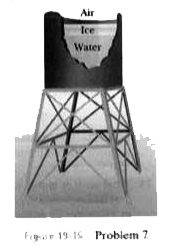A 3.0 cm slabe has formed on an outdoor tank of water . The air is at . Find the rate of ice formation (centimeters per hour). The ice has thermal conductivity 0.0040 cal and density .Assume there is no energy transfer through the walls or bottom.

The correct Answer is:2.55 10 0.92 cmh
Step by step video & image solution for A 3.0 cm slabe has formed on an outdoor tank of water . The air is at -14^(@)C. Find the rate of ice formation (centimeters per hour). The ice has thermal conductivity 0.0040 cal//s.cm.""^(@)C and density 0.92g //cm^(3).Assume there is no energy transfer through the walls or bottom. by Physics experts to help you in doubts & scoring excellent marks in Class 12 exams.
Topper's Solved these Questions
- BOOK - RESNICK AND HALLIDAYCHAPTER - HEAT-MEASUREMENT AND TRANSFEREXERCISE - PRACTICE QUESTIONS60videos
HEAT-MEASUREMENT AND TRANSFER
- BOOK - RESNICK AND HALLIDAYCHAPTER - HEAT-MEASUREMENT AND TRANSFEREXERCISE - PRACTICE QUESTIONS(MORE THAN ONE CORRECT CHOICE TYPE )8videos
HEAT-MEASUREMENT AND TRANSFER
- BOOK - RESNICK AND HALLIDAYCHAPTER - HEAT-MEASUREMENT AND TRANSFEREXERCISE - CHECKPOINT 21videos
HEAT-MEASUREMENT AND TRANSFER
- BOOK - RESNICK AND HALLIDAYCHAPTER - GRAVITATIONEXERCISE - PRACTICE QUESTIONS (INTEGER TYPE)4videos
GRAVITATION
- BOOK - RESNICK AND HALLIDAYCHAPTER - HYDROGEN ATOMEXERCISE - PRACTICE QUESTIONS(Integer Type)6videos
HYDROGEN ATOM
Similar Questions
The thickness of ice in a lake is 5cm and the atmospheric temperature is 10∘C Calculate the time rquired for the thickness of ice to grow to 7cm Therml conductivity for ice =4×10−3calcm−1s−1c−10 density of ice =0.92g/cm3 and latent heat of fusion of ice =80cal/g .
View SolutionWhen the air temperature is −10∘C, the ice on a large shallow lake in creases by 1cm in 12minutes. Find the thermal conductivity of ice. (Density of ice =900kgm−3 and L=330×103Jkg−1)
View Solution
Knowledge Check
- Question 1 - Select One
A lake is covered with ice 5 cm thick and the atmospheric temperature above the ice is–10∘C. At what rate (in cm/hour) will the ice layer thicken? Thermal conductivity of ice =0.005 cgs unit, density of ice =0.9g/ and latent heat of fusion of ice = 80 cal/g.
A0.5cm hr−1B1.5cm hr−1C2.5cm hr−1D3.5cm hr−1 - Question 2 - Select One
Time in which a layer of ice of thickness 10 cm will increase by 5 cm on te surface of a pond when temperature of the surrounding is −10∘C coefficient of thermal conductivity of ice K=0.005(Calcm−sec−.∘C) and density ρ=0.9gram/cm3 (L=80cal/g)
A20 HoursB25 HoursC30 HoursD5 Hours - Question 3 - Select One
A 5cm thick ice block is there on the surface of water in a lake. The tmeperature of air −10∘C, how muct time it will take to double the thickness of the block?
(L=80cal/g,Kice=0.004cal/s−K,dice=0.92gcm−3)A1hourB191hourC19.1hourD1.91hour
Ice has formed on a shallow pond, and a steady state has been reached, with the air above the ice at −5.0∘C and the bottom of the pond at 4.0∘C. If the total depth of ice + water is 2.0m, how thick is the ice ? (Assume that the thermal conductivity of ice and water are 0.40 and 0.12 cal/m.∘C.s, respectively. )
View SolutionA lake surface is exposed to an atmosphere where the temperature is <0∘C. If the thickness of the ice layer formed on the surface grows form 2cm to 4cm in 1 hour. The atmospheric temperature, Ta will be- (Thermal conductivity of ice K=4×10−3cal/cm/s/.∘C, density of ice =0.9gm/ice. Latent heat of fustion of ice =80cal/m. Neglect the change of density during the state change. Assume that the water below the ice has 0∘ temperature every where)
View SolutionThere is ice formation on a tank of water of thickness 10 cm.How much time it will take to have a layer of 0.1 cm below it ?The outer temperature is −5∘C, the thermal conductivity of ice is 0.005calcm−1∘C−1 and latent heat of ice is 80cal/g and the density of ice is 0.91gcm−3:
View SolutionA refrigerator converts 100 g of water at 25∘C into ice at −10∘C in one hour and 50 minutes. The quantity of heat removed per minute is (specific heat of ice = 0.5cal/g∘C, latent heat of fusion = 80cal/g)
View SolutionIce has formed on a shallow pond, and a steady state has been reached, with the air above the ice at −5.0∘C and the bottom of the pond at 40∘C. If the total depth of ice + water is 1.4m, (Assume that the thermal conductivities of ice and water are 0.40 and 0.12cal/mC∘s, respectively.)
The thickness of ice layer isView Solution

